Of Damsels and Dragons...
 Saturday, November 6, 2010 at 03:33PM
Saturday, November 6, 2010 at 03:33PM After a false start with one brief shower on 23rd October, the rainy season started with a real vengeance on the evening of 2nd November, with a storm the likes of which we have never experienced before here at Kulafumbi. It's a shame we don't have a rain gauge, otherwise I could have wowed you with figures! But suffice to say, by morning, we felt battered and bruised and very, very wet (our house has certain defects when it comes to keeping the rain out, and being in such an exposed location makes us especially vulnerable to the wind and the weather.)
Although the Athi River remained staid and green and only half full, the Mtito River came roaring down in a mighty flash flood during the night, pounding its way through the darkness like a steam train. By morning, the Mtito was still flowing, albeit gently by then, and the only sign of the night before was the erosion and the flood marks scarring the sand where the Mtito joins the Athi:
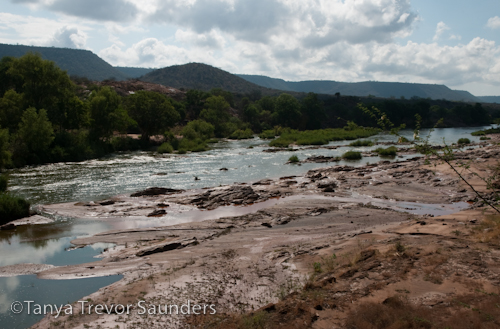
You can see the erosion-red Mtito water constrasting with the green of the Athi:
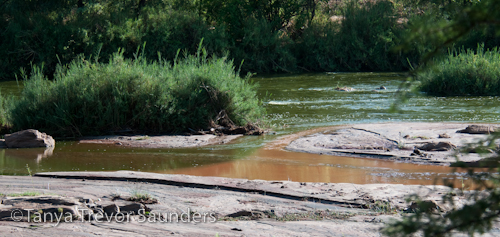
Erosion gullies into the Mtito are evidence of the previous night's heavy rain:
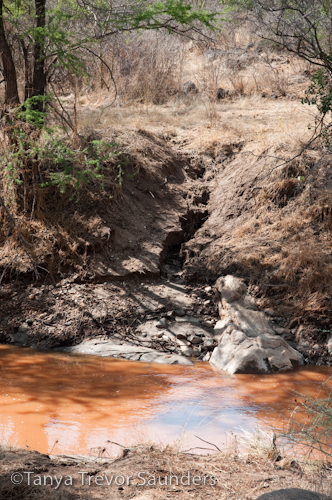
The morning after the vicious storm, all seems tranquil on the Mtito:
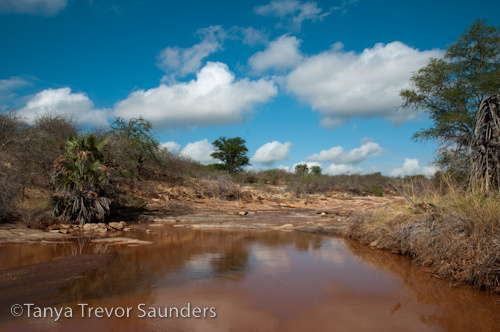
The first morning after the rain is like no other. There is such an urgency to the celebrating that goes on amongst the birds and animals. On the Mtito River, the frogs were going crazy, their voices rising in a cacophony of squawks and croaks. The insects were humming furiously and already courting and mating. I decided to walk up the Mtito River to photograph the damselflies which were out in a profusion of different colours, linking up and mating on the wing.
Any longterm readers of this journal will remember that, as soon as the Mtito starts to flow after its many months as a dry sand river, this photographer is not the only creature which ventures upstream...and hence the title to my story, and the warning: "When going in search of damsels, beware of dragons!" For crocodiles too move up the newly flowing Mtito, though not in search of damselflies: they come to prey on the fish, which are also making their way upstream and, when trying to climb up the small rocky falls, often fall back down, right into a crocodile's conveniently-located open mouth!
A pool on the Mtito, though red and muddy, can look inoccuous enough:
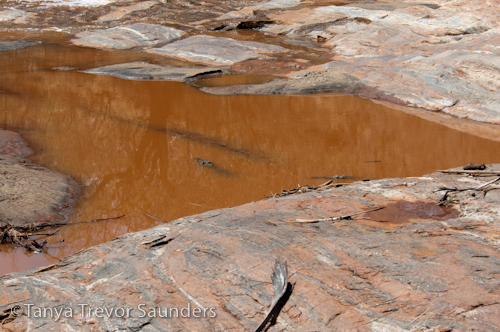
But beware what lurks beneath the surface: two crocodiles (or possibly more - who knows in that murky water?)
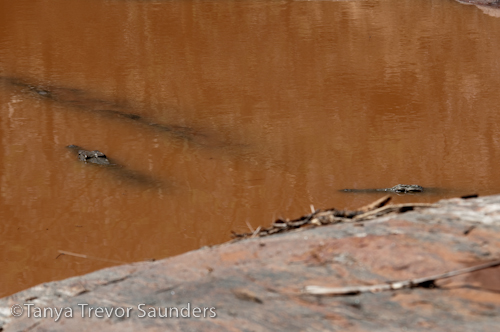
Crocodiles have an incredible aptitude for disappearing. This sequence of photos follows a crocodile moving downstream from one pool to another, through river channels and across open rock, and then disappearing entirely from sight into a muddy pool...showing why one should always be on one's guard around the water's edge, for you never can tell what lies within!
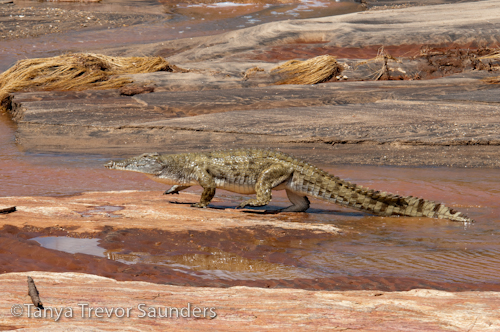
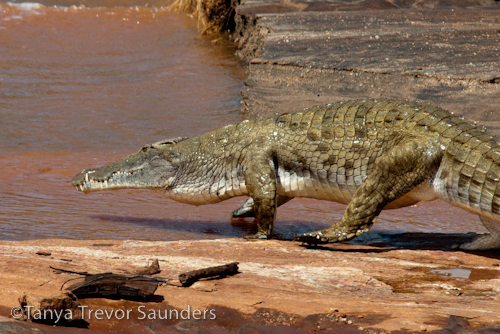
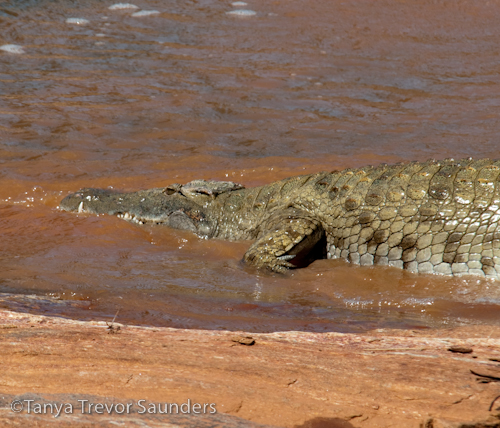
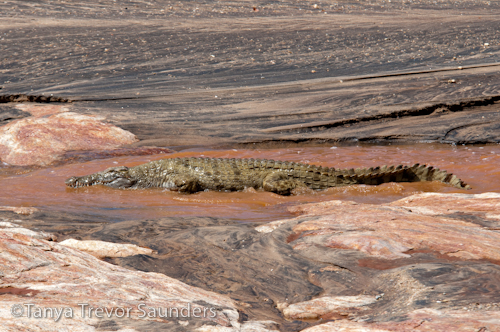
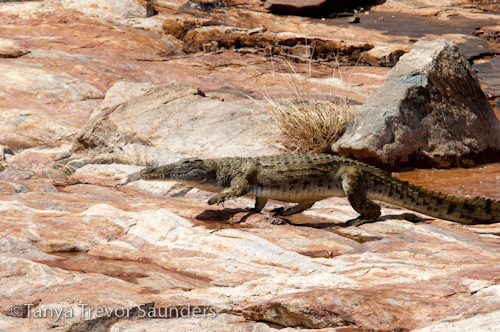
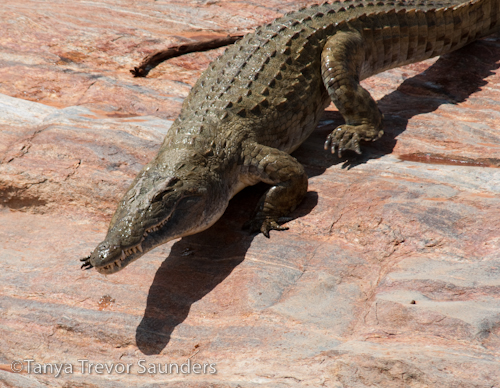
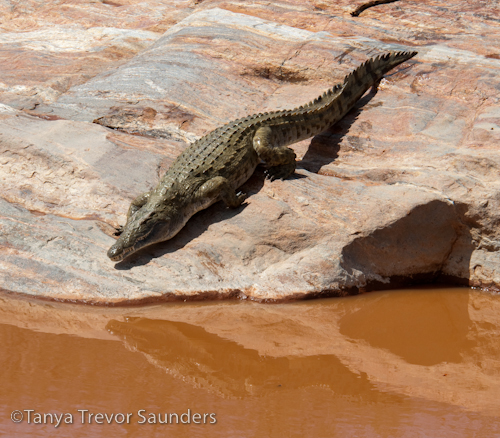
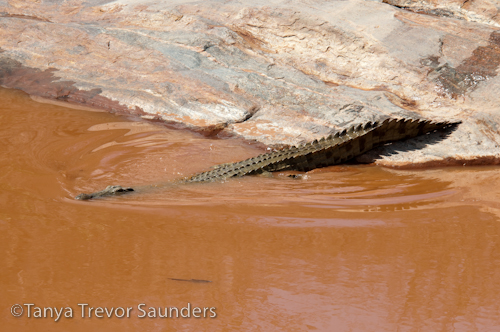
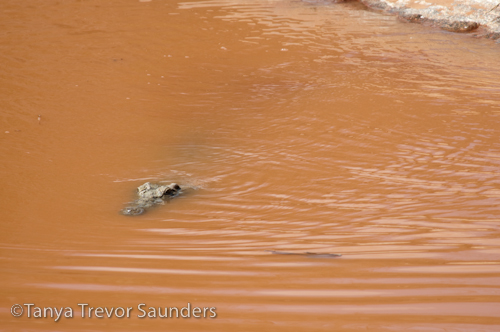
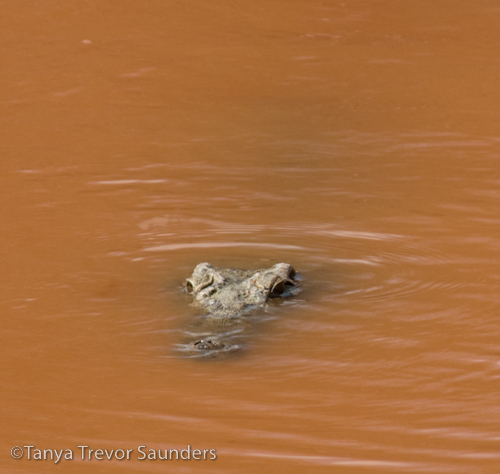
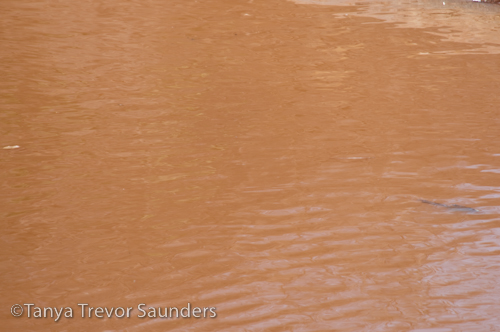
And gone....and who would have known that not one, but two crocodiles wait beneath the surface?
Though somewhat distracted by all the crocodile action, I did get a few shots of the damselflies (and dragonflies) I had set out to photograph, but nothing to write home about really. Here is one of many different types of dragonfly, perching momentarily on some debris at the water's edge (one of the differences between damselflies and dragonflies is that dragonflies hold their wings perpendicular to their body when at rest, while a damselfly will hold its wings along/parallel to its body...and dragonflies are generally more heavily-built and are better fliers, venturing further from water than damselflies do):
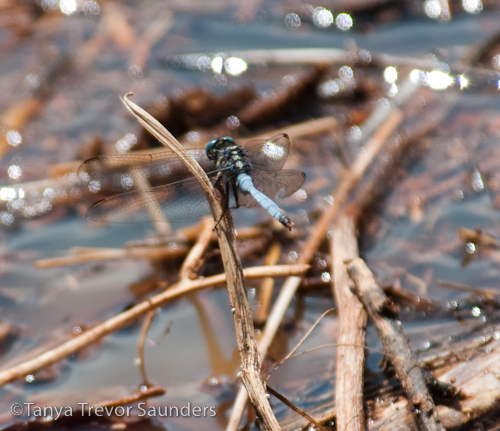
And who would have thought it, but the damselflies seemed rather drawn to the floating islands made by this crocodile's snout. I don't know if you can see it here, but there's a damselfly perched right on the crocodile's nostril, and another one flitting around near its eye (in the second photo below):
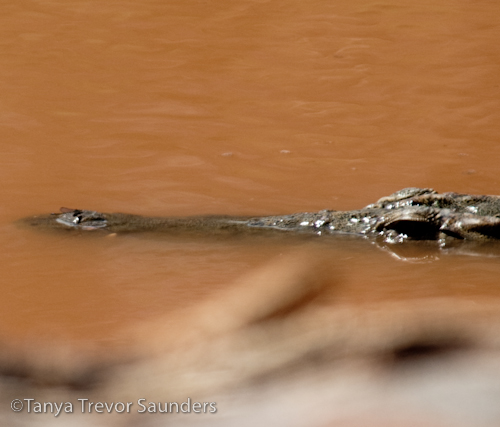
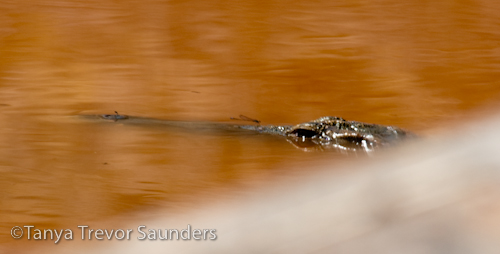
The frogs certainly wasted no time during the first night of the rains, leaving pretty frog spawn polka dots across the stagnant pools left behind after the flash flood. It would be interesting to know if this long-legged insect is feeding on the frog's eggs, or has just landed here by chance:
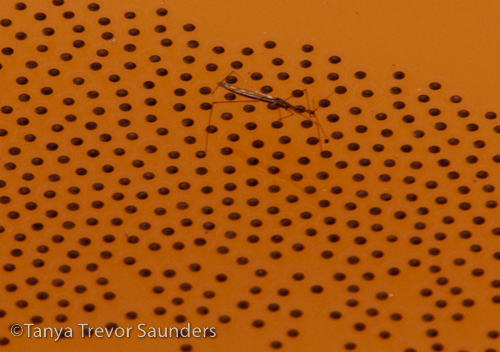
Here's another water walker:
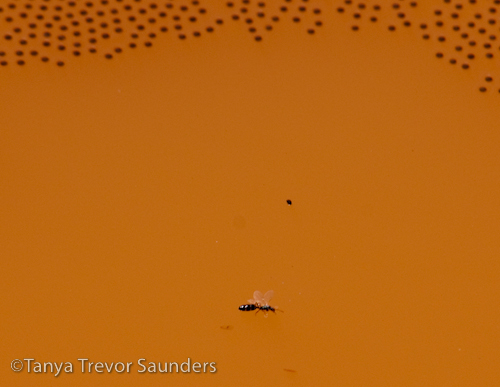
Being too raucous can have its downsides. The frogs, in all their exuberance, become easy pickings for the Hammerkops...
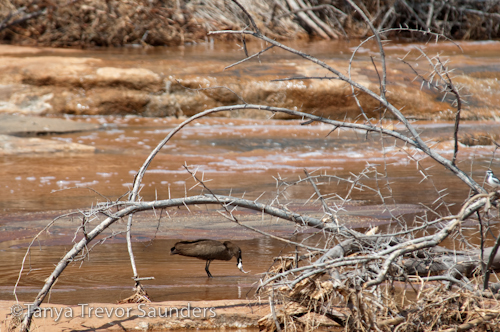
...though some of the Hammerkops seem to have eyes somewhat bigger than their stomachs, and simply cannot swallow the huge frogs they catch with such apparent ease:
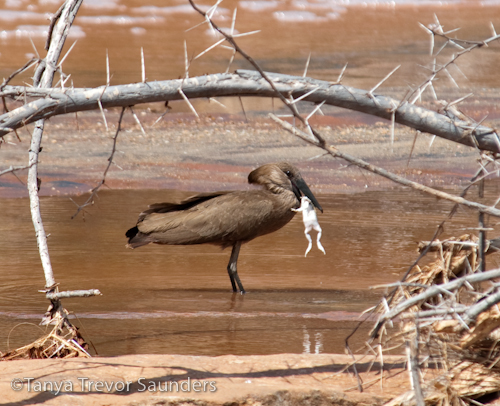
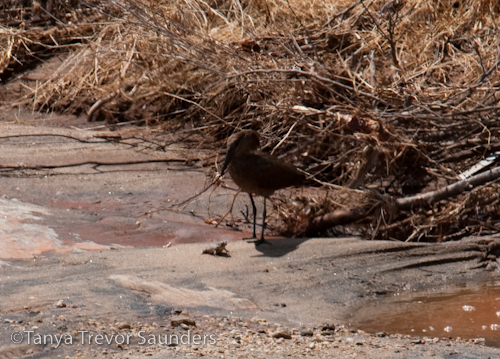
This frog was a lucky one...after grappling with it, the Hammerkop decided it simply could not swallow such a big fellow, and unceremoniously dropped the frog on the sand (you can see the frog sitting in front of the Hammerkop). The frog hopped off, apparently unharmed but no doubt feeling a sense of relief to live another day!
Some of the first creatures to emerge after the rain are Red Velvet Mites. They are indicators that the dry times are over, for they only emerge from the ground (legs first to feel the moisture content in the air before they venture out) after very heavy rain. These bright red arachnids are extraordinary creatures. I'm never quite sure whether I'm enamoured or ever so slightly repulsed by them - it's something to do with the allure of their velvety appearance on the one hand, and on the other the fact that they are most closely related to ticks (and to spiders - which I don't mind at all.) They're about 1cm long (making them giants of the mite world - different species occur across America, Europe, Asia and Africa) and when they emerge after the rain, they move industriously about in and around leaf debris. Apparently termites are their main food. They are totally harmless to humans. Their bright red colour alerts potential predators to their foul taste, so they are relatively immune to predation during the few short hours they spend foraging above ground after the first rain. I have often seen these creatures in Tsavo after heavy rain, but this time, I watched some interaction between two mites, which caused me to start reading up a little more about them (hence the lengthy paragraph here!).
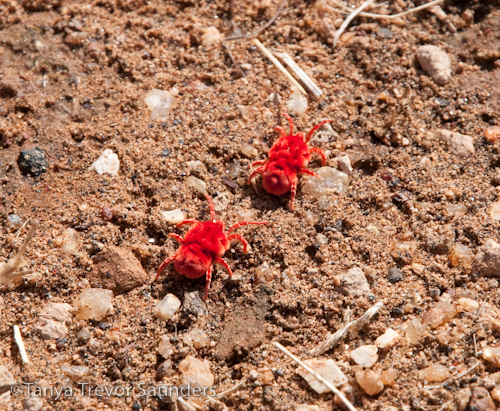
It was hard to tell whether the mite at the back was deliberately following the one in front, or whether it was a random meeting.
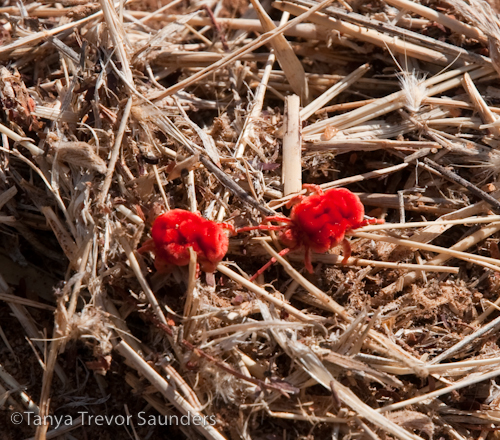
When the front mite crawled up onto a pile of leaf litter, the other followed. This prompted the front mite to curl up, tucking its legs underneath its body. This behaviour would normally indicate that the mite felt threatened. So was the one mite afraid of the other, or what was going on?
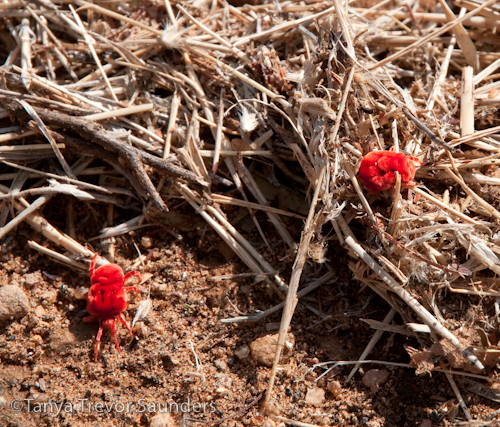
With the one mite still tucked up in a ball on top of the leaf litter, the other mite crawled down to the ground and started running repeatedly round and round in a tight circle. Apparently, according to my research, this is courtship behaviour and this is a male mite spinning a web on the ground to attract the female. However, my intuition tells me that, from the look of her posture, the female up top is saying "Thanks but no thanks"!
The emergence of the Red Velvet Mites might be indicators that the rains have come in earnest, but there are many indicators which signal the coming of the rain, sometimes many days (even weeks) in advance. The Acacia Tortillis trees will turn green six weeks before the rain. Many of the Commiphora trees will start budding with tiny green shoots as soon as there is a change in the moisture content of the air, before the rain actually falls. I've often talked of the Fireball Lilies which normally predict the rain by flowering 10 days before it starts - although this year, the Fireball Lilies on our balcony (below) have flowered in three phases, the final bloom to emerge being absolutely huge - perhaps presaging the unusually ferocious first storm of the rainy season! It must be said that even the lilies looked a little bedraggled the morning after the onslaught:
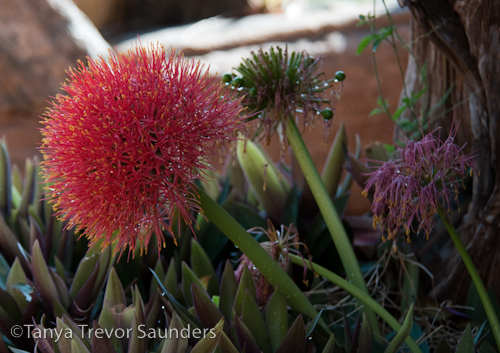
The Baobab trees are more confusing. Some flowered before the rain, and some have yet to flower. I don't know if you can tell from the photo below, but the flowers of the Baobab tree in the foreground are already dying and wilted, while the large tree far in the background has yet to flower. It's also interesting to note that the tree in the foreground already has green leaves on it, while the giant in the background is still bare-boughed. This photo was taken the first morning after the rain too:
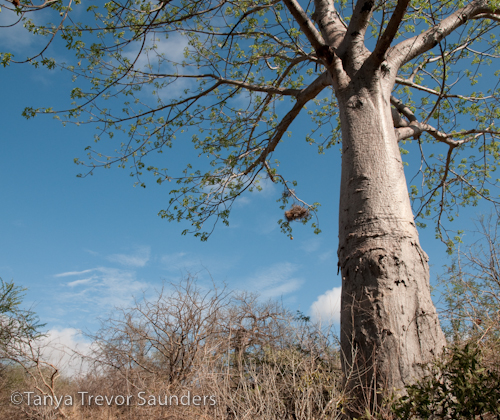
Whichever way you look at it, nature is amazing. Often, it confounds logic. Take a look at the tiny delicate seeds on this small spindly plant, still beautiful in the dull grey light of a post-rain morning. How did they survive without being smashed off their stem by the ferocity of the previous night's storm? For me, the moral of the story is: "Never underestimate the great hidden strength of nature - you may do so at your own peril!"
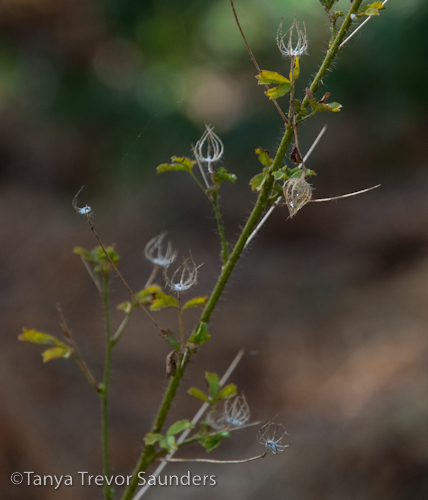





Reader Comments (11)
Wow, amazing photos! I particularly liked the one of the Hammerkop and the frog. Great shot!
Hi
If you are travelling to London than you can try Hummingbird Cars http://www.hummingbirdcars.com I have tried them For London airport Transfer and they are pretty good and Affordable. They Provide Transfers from all the five London Airports: Gatwick, Luton, London City, Stansted and London Heathrow Airpots. They have very well behaved Drivers who respect their customers. They also provide a MEET and GREET Service. They have well maintained Saloon, Estate, People Carriers (MPV's) and large Public Carriers. In addition to this they offer good discounts on bookings.
Nice photos...
I have never seen any crocodile catchiing up any animal...
do you have the photos of it.....
thanks in advence...
from dandeli jungle resort
Nice post with excellent pictures. The pictures alone would make me want to go there, because they show how much character the place has!
Love to see the crocodile from so closely..Excellent click ,nice pics....
Such great and wonderful photos! This reminds of the legendary crocodile hunter. It's been so much fun watching his shows dealing with crocodiles.
Great work once again my you...Kulafumbi is a good natural landscape for sightseeing,as you have also shown this in your post..The Athi river is looking great ,but seems to be dangerous,as the crocodile s are there.....the pic of hammerkop and frog is the best here...I liked it..
thanks by admin
www.bestoffrm.com
Thanks for sharing the wonderful information on the nature and I have never seen the pics of crocodiles like this..It was an amazing view..I also want to see them live..Any idea where I can..I am from Alaska..Any near base?The river pics are awesome and seriously great photography..
With regards
location calella
A fascinating paper.
I love reading your writing
I got a lot of input
thanks and encouragement to keep writing.
Helping people is a best way to show kindness, but helping people and providing information in a great way to help and being human, keep it up as you can never know how important your knowledge could be for others who in need. Thanks.